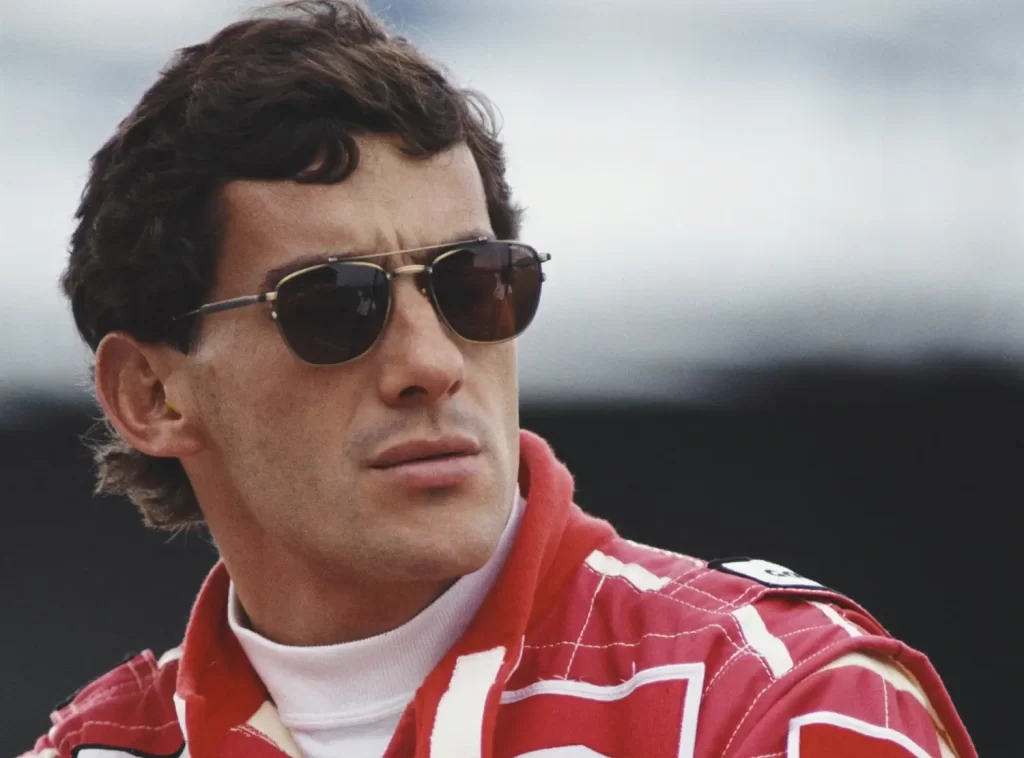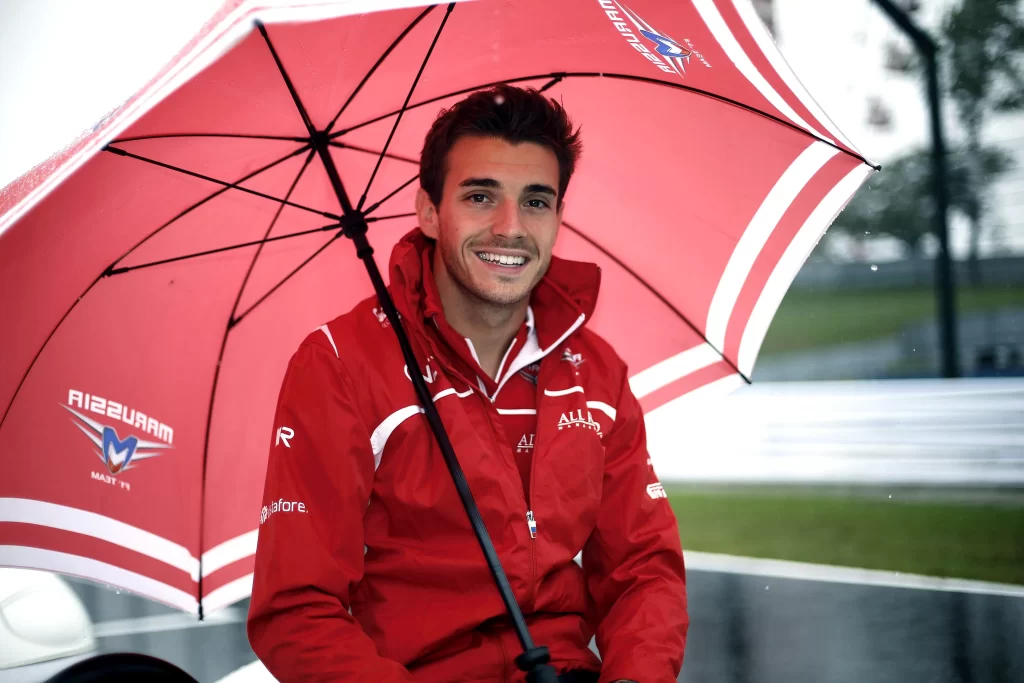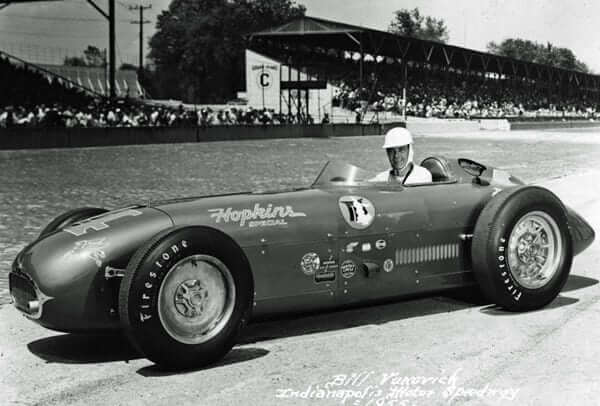Formula 1 fans often wonder just how many F1 drivers have died from fatal crashes as they know that pushing those blistering speeds comes at an actual human cost.
While there have been 52 deaths in Formula 1 as of 2022, only 5 have occurred since the turn of the century due to positive changes in safety regulations.
Below we look at some of the incidents that have made that possible.
The 10 Most Notable F1 Driver Deaths in History
Now that you know how many Formula 1 drivers have died due to on-track crashes, let’s take a closer look at the ten most unfortunate fatalities.
1. Chet Miller

- Date of accident: 15 May 1953
- Event: Indianapolis 500
- Circuit: Indianapolis Motor Speedway
Known as the ‘Dean of the Speedway’, this US-born mechanic and driver had been racing in the Indi 500 for more than 20 years between 1930 and his death at 50 years of age in 1953.
However, despite his experience, he became the first driver to lose his life in a FIA World Championship event when he crashed in the speedway’s south turn in 1953.
However, Miller’s Grand Prix death was only the start of the tragedies that were to come at this infamous speedway, where six more fatal accidents took place during the following six years.
2. Ayrton Senna

- Date of accident: 1 May 1994
- Event: San Marino Grand Prix
- Circuit: Autodromo Enzo e Dino Ferrari
For many, one of if not the greatest F1 drivers of all time—Ayrton Senna—was fearless, fast, and ferocious driver without a match, and his death echoed his relatively short life.
Between 1988 and 1991, the Brazilian won three World Championships and never lost his determination and hunger for wins, even during that ill-fated Sunday at the San Marino GP.
As he was rounding the Tamburello corner on Lap 7 at 310 kph, he inexplicably left the racing line, hit the concrete wall opposite, and left the world an F1 racing legend.
3. Roland Ratzenberger

- Date of accident: 30 April 1994
- Event: San Marino Grand Prix
- Circuit: Autodromo Enzo e Dino Ferrari
Senna’s was only one of two F1 fatalities during that disastrous San Marino weekend, as the Austrian Roland Ratzenberger also lost his life during the qualifying session the day before.
Despite being overshadowed by Ayrton’s death, Ratzenberger’s untimely demise is no less unfortunate as he has only completed two F1 races before perishing in a crash.
The cause of the accident was a damaged and loose front wing that got lodged under the car, which ultimately threw him into the outside wall of the Villeneuve corner at almost 315 kph.
You might also be interested in: What is DRS in F1?
4. Jules Bianchi

- Date of accident: 5 October 2014
- Event: Japanese Grand Prix
- Circuit: Suzuka International Racing Course
The last F1 death to have been caused by a race incident is that of the young and hopeful French driver Jules Bianchi who died tragically after his 2014 Japanese GP accident.
Many fans believed they wouldn’t witness any more F1 drivers’ deaths after the double San tragedy of 1994, but 20 years later, disaster struck again on the cold and wet Suzuka track.
Essentially, Jules lost control of his car, hit the back of a recovery vehicle, and sustained a grave head injury that put him in a coma, to which he succumbed several months later.
Note: Bianchi’s death precipited the development of the halo system—the latest and most innovative safety solution that has since saved numerous drivers from injuries or death.
5. Manny Ayulo

- Date of accident: 16 May 1955
- Event: Indianapolis 500
- Circuit: Indianapolis Motor Speedway
Next up on our list of unfortunate F1 driver deaths are the two horrific incidents to take place during the 1955 Indi event, the first of which is Manny Ayulo’s crash during a practice run.
Before his fatal accident that partly included a foolish mistake on his part, Manny was an exceptional driver that helped establish roadsters as track-worthy race cars.
However, on the day in question, he did not put on a seatbelt but instead filled his pockets with wrenches, which didn’t prove helpful at all when he crashed his car into a concrete wall.
Related: Why do F1 drivers get weighed?
6. Bill Vukovich

- Date of accident: 30 May 1955
- Event: Indianapolis 500
- Circuit: Indianapolis Motor Speedway
Only two weeks later, fomer Indy winner and a superb driver—Bill Vukovich—was leading the race with 17 seconds before perishing in a chain collision with backmarkers.
Specifically, on lap 57, Bill was about to pass three slower drivers when a freakish set of circumstances resulted in a stray car hitting his, after which it went over the outside wall.
Vukovich’s death occurred as a result of impacting a low bridge as it somersaulted in the air and the subsequent flames after the car landed upside down on top of other vehicles.
Did you know: Formula 1 races used to run for almost three hours during the sport’s infancy, which led to greater driver fatigue and an increased risk of injury.
7. Tom Pryce

- Date of accident: 5 March 1977
- Event: South African Grand Prix
- Circuit: Kyalami Racing Circuit
Tom Pryce’s death was one of those F1 fatalities that became a cautionary tale as it was completely avoidable only if race control and the marshals did their job correctly.
On that miserable day, a driver pulled over by the side of the road just after the brow of a hill as his car caught on fire, which required two marshals to cross the road to help him.
While the first volunteer narrowly got away with his life, the second 19-year-old marshal was not quick enough as he was struck by Pryce’s car at 270 kph while carrying a fire extinguisher.
Both the teenager and the Welsh driver died instantly, with the first being thrown in the air and landing several meters away, and Pryce from a blow in the head from the fire extinguisher.
8. Ronnie Peterson

- Date of accident: 10 September 1978
- Event: Italian Grand Prix
- Circuit: Autodromo Nazionale di Monza
Considered one of the best F1 to have never won a championship, this Swedish driver met an untimely end as a result of a chain accident at the start of the 1978 Italian Grand Prix.
The race weekend started badly for the Swede as he damaged his car, so it had to be replaced with that of his teammate’s, which offered much less room for his legs.
As the cars sped up before bunching up at the first chicane, chaos ensued as those at the back tried to pass with one car hitting Peterson, which then flew into the barriers and caught fire.
Despite being freed from the wreckage and seemingly avoiding death, Ronnie has suffered 27 fractures in his legs, which ultimately led to complications, kidney failure, and hospital death.
9. Gilles Villeneuve

- Date of accident: 8 May 1982
- Event: Belgian Grand Prix
- Circuit: Circuit Zolder
This multiple-race winner and Canadian F1 legend died during the qualifying session for the 1982 Belgian Grand Prix after crashing into the much slower Jochen Mass.
With a few minutes left in qualifying, Gilles attempted to pass the slower car on the right, but Mass also thought of moving to the right to get off the racing line.
Due to this misunderstanding, Villeneuve hit Moss, got launched into the air, was ejected along with the seat, and suffered a fatal neck injury upon landing 50 metres from the car.
10. Riccardo Paletti

- Date of accident: 13 June 1982
- Event: Canadian Grand Prix
- Circuit: Circuit Gilles Villeneuve
The ill-fated 1982 World Championship claimed one more fatality a month later at a circuit that now carries the name of history’s greatest Canadian driver—Gilles Villeneuve.
Riccardo Paletti was a young Italian who perished during his first and last full F1 line-up after crashing in the back of a stalled Ferrari car as he couldn’t react and avoid it in time.
The 180 kph impact crushed in his car, which caught fire soon after that, but the damage was already done as the young driver had already sustained life-ending chest injuries.
Grand Prix Death Statistics
The vast majority of the 52 F1 drivers’ deaths have been recorded during the first three decades at a time of lax safety regulations and the emphasis on daring speed.
For instance, the 1950s (15), 1960s (14), and 1970s (12) saw 41 combined F1 fatalities.
Moreover, 31 out of all fatal crashes happened during official FIA race weekends, 13 during unofficial F1 events, and 7 during test sessions outside the calendar.
Finally, in terms of nationality, the UK, with 14 and the US, with 10 drivers each, have had the most casualties, while the most dangerous circuits have been Indianapolis (7 deaths), Nürburgring (5 deaths), and Silverstone (4 deaths).
F1 Safety Improvements Throughout the Years
As the pinnacle of motorsports, F1 is constantly pushing the limits of engineering ingenuity despite the high costs of manufacturing its cars, and during its most recent decades, it has started applying the same innovative approach when it comes to its safety solutions.
For instance, to prevent deaths in Formula 1, the governing body has been introducing different safety measures since the sport’s inception, the most important of which include:
- Safety marshals since the 1950s—volunteers have been present on track since the very beginning, working as first responders and incident handlers;
- Mandatory helmets since 1952—it all started with cloth caps and goggles, before moving onto cork helmets soon thereafter and carbon fibre helmets in 2021;
- Fire-resistance suits since 1975—since most F1 crashes lead to violent fires, F1 drivers have to be adequately protected with fireproof overalls;
- Survival cell since 1981—the monocoque is the driver’s seating shell and is built from a carbon fibre composite that is all but indestructible;
- Permanent safety car since 1993—keeps the car speeds down and stops overtaking while the marshals are clearing any hazards present on the track;
- Headrest padding since 1996—used in combination with the HANS device (introduced in 2003), it reduces strain and prevents excessive movement of the head and neck;
- Wheel tethers since 1999—prevent wheels from detaching from the car during an accident and injuring other drivers or marshals;
- Refuelling ban since 2010—due to various incidents of rogue fueling hoses causing unexpected flames and putting pit crews and drivers in danger;
- Super licence since 2016—introduced to ensure teams can only use drivers with single-seater racing experience who are at least 18 years of age;
- Halo system since 2018—this head-protection bar was implemented as a result of the last F1 death recorded during a race, that of Jules Bianchi in 2014, and has saved other drivers from serious injuries or death on numerous occasions.
As you can see, despite being the fastest single-seater series, thanks to the extreme 1,000 hp setup of its engines, F1 is one of the safest motorsports around, especially when compared to MotoGP, with bikes reaching 300 kph and WRC, with rally cars driving through hills on barely wide enough roads at 200 kph.
Bottom Line
Hopefully, our article has helped you understand how many F1 drivers have died to make these high-performing machines safe enough for drivers to push to the limits of their minds and bodies, so we enjoy the flashy cars, the roar of their engines, and the daring overtakes.

